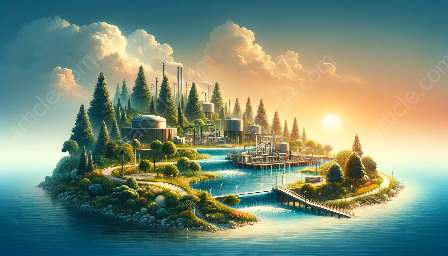Port and coastal developments are essential for global trade and economic growth, but they often have significant environmental impacts. These impacts can affect water quality, marine ecosystems, and coastal communities. Understanding the environmental consequences of port and coastal developments is crucial for sustainable engineering practices in water resource and coastal engineering.
Environmental Impacts of Port and Coastal Developments
Coastal and port engineering involves the construction and maintenance of infrastructure such as ports, harbors, and coastal protection structures. While these developments play a vital role in facilitating international trade and transportation, they also have far-reaching effects on the environment. By understanding these impacts, engineers can implement sustainable solutions to mitigate the negative consequences.
Water Quality
One of the primary environmental impacts of port and coastal developments is the deterioration of water quality. The construction of ports and associated infrastructure often leads to increased sedimentation, industrial runoff, and contamination from shipping activities. These pollutants can degrade water quality, harm aquatic life, and disrupt marine ecosystems. Coastal and port engineering practices need to incorporate measures to minimize the release of pollutants and protect water quality.
Marine Ecosystems
Port and coastal developments can have profound effects on marine ecosystems. The construction of coastal structures and dredging activities can disrupt natural habitats, alter sediment transport, and impact marine biodiversity. Additionally, increased maritime traffic from ports can lead to ship strikes, underwater noise pollution, and oil spills, posing significant threats to marine life. Engineers specializing in coastal and port engineering must consider the ecological implications of their projects and work towards preserving and restoring marine ecosystems.
Coastal Communities
The development of ports and coastal infrastructure can also influence nearby communities. Coastal erosion, changes in sediment dynamics, and altered coastal processes resulting from engineering activities can affect the livelihoods and safety of coastal communities. Effective coastal and port engineering approaches should aim to minimize these impacts and promote community resilience through sustainable coastal management strategies.
Sustainable Solutions and Best Practices
To address the environmental impacts of port and coastal developments, water resource and coastal engineers employ various sustainable solutions and best practices. These include:
- Integrated Coastal Zone Management: Implementing comprehensive plans that consider the social, economic, and environmental aspects of coastal areas to achieve sustainable development.
- Low-Impact Design Techniques: Employing innovative engineering designs and materials to minimize the ecological footprint of port and coastal infrastructure.
- Nature-Based Solutions: Utilizing natural and nature-based features to enhance coastal resilience, reduce erosion, and provide habitat for marine species.
- Technological Innovations: Leveraging advanced technologies such as remote sensing, predictive modeling, and ecological monitoring to assess and mitigate environmental impacts.
- Regulatory Compliance: Adhering to environmental regulations and standards to ensure that port and coastal developments meet sustainability criteria and maintain environmental quality.
Conclusion
Port and coastal developments have the potential to significantly impact the environment, necessitating a holistic approach to sustainable engineering. By integrating the principles of water resource engineering and coastal engineering, practitioners can minimize the negative environmental effects of these developments while maximizing their social and economic benefits.

